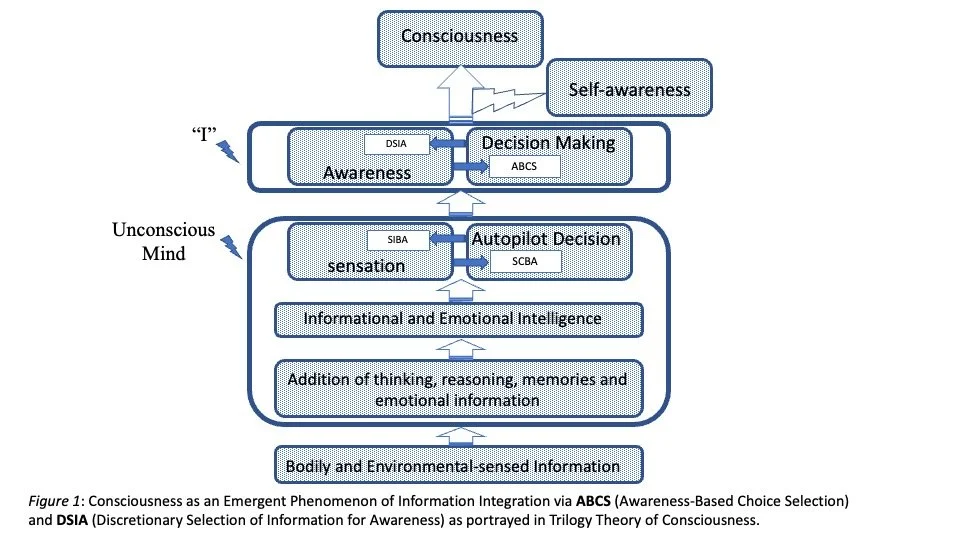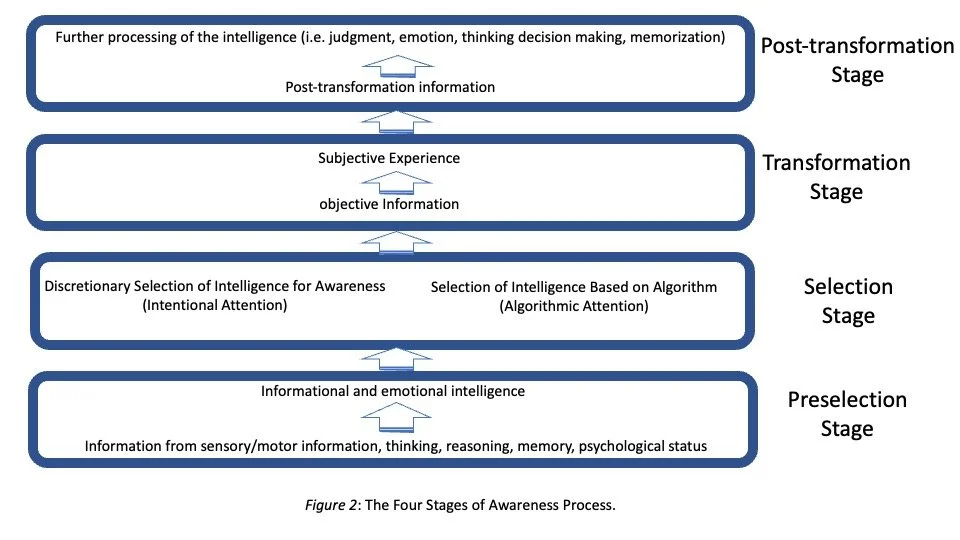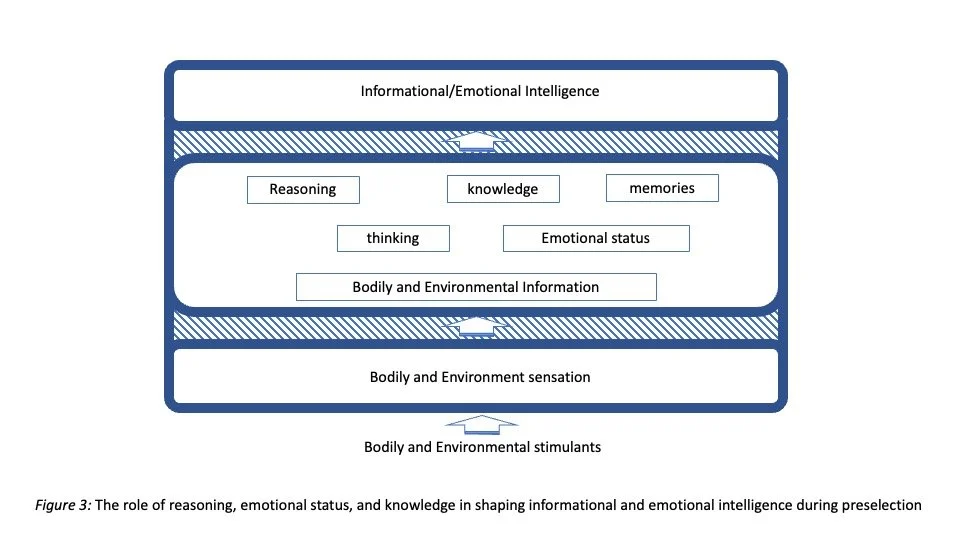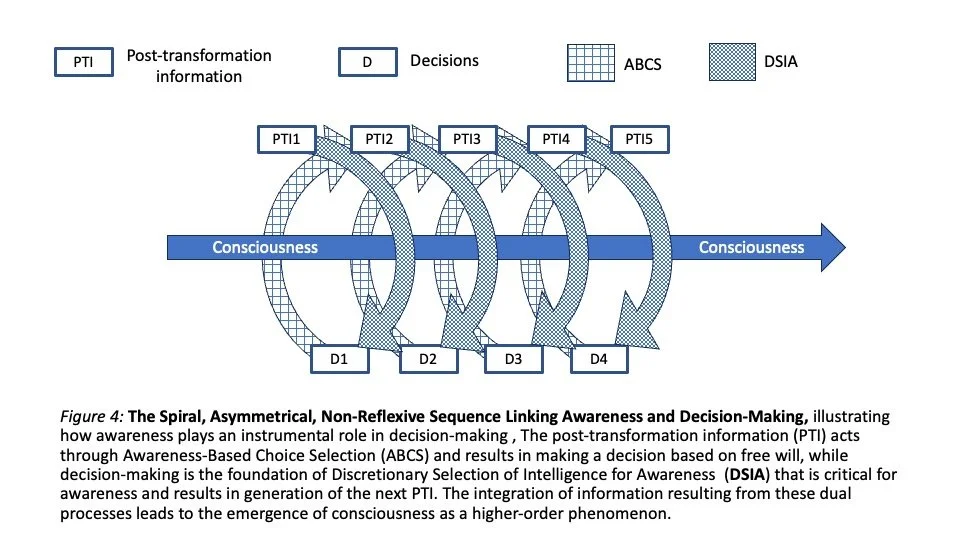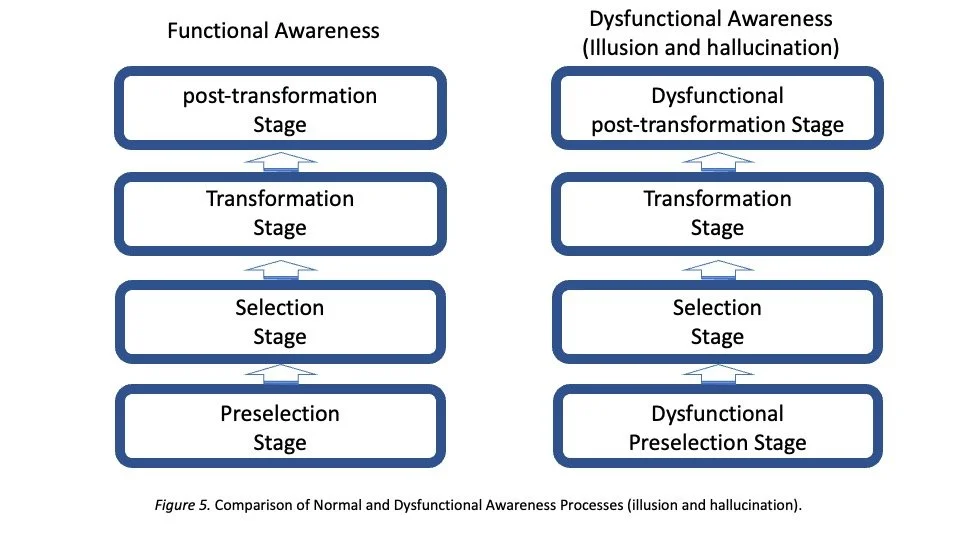Awareness at the Crossroad of Illusion and the Soul
Abstract
Awareness and consciousness are often used interchangeably, yet they represent distinct cognitive phenomena. While consciousness is commonly perceived as a state of mind encompassing one’s environment and self, awareness is the subjective experience derived from objective mental processes. This transformation converts sensation into perception, knowledge into knowing, emotion into feeling, and memory into remembering. Despite its undeniable importance, awareness challenges the current physical framework of brain function, sparking debates about its nature. Some scholars argue that awareness is an illusion—an interpretative process of the brain adapted to reality—while others equate it to the immaterial and immortal concept of the soul. This article examines awareness as a cognitive construct within the Trilogy Theory of Consciousness (TTC) and explores its role in processes such as awareness-based choice selection (ABCS). It further differentiates awareness from illusion—a dysfunctional cognitive process—and from the metaphysical notion of the immaterial soul. Finally, it underscores the critical role of awareness in self-reflection and decision-making.
Awareness versus an Illusion?
Many scholars have argued that awareness is nothing but an illusion. Daniel Dennett, one of the pioneers of this idea, contended that awareness arises from the brain's interpretive processes rather than its objective mechanisms (Dennett, 1991). This notion has been echoed by other philosophers such as Franklin and Brent (Frankish, 2016). In this view, the brain’s interpretation reconstructs reality, piecing together incomplete sensory information and filling in the gaps with knowledge from prior experiences and predictions. As a result, awareness is considered a constructed perception designed to make sense of what is happening. Since the perception involves a constructive, interpretative process rather than a direct reflection of sensory inputs, thus supporting the claim regarding the gap between sensation and perception as evidence of mental reconstruction (Gregory, 1997). Consequently, proponents of this perspective conclude that awareness is nothing more than an illusion.
However, from a literal perspective, an illusion is defined as a sensory deception, false belief, intellectual error, or misleading appearance (Berent, 2024). This essay challenges this notion by examining the function and variations of awareness through the lens of the Trilogy Theory of Consciousness (TTC) (Farhadi, 2021). According to TTC, awareness is not merely a byproduct of cognitive reconstruction but rather the keystone of human experience and the foundation for meaning in life.
Awareness is a function not a dysfunction:
Based on TTC, awareness is the keystone to consciousness and is not the end product of the interpretation of reality but rather the stepping stone for understanding the world and making decisions based on free will through the mechanism of awareness-based choice selection (ABCS). According to TTC, the awareness process comprises four distinct stages: preselection, selection, transformation, and post-selection stages.
The TTC posits that humans are composed of three fundamental elements: the body, the mind, and the "I". In this framework, the "I" emerges from the interplay between two cognitive functions: "Awareness-Based Choice Selection," or free will, and "Discretionary Selection of Information for Awareness," or intentional attention. This interaction acts as the gateway linking the unconscious mind to awareness, forming the basis for the experience of self-awareness (Figure 1).
Unlike traditional theories that equate consciousness directly with awareness, the Trilogy Theory differentiates these concepts, redefining consciousness as the dynamic interaction between awareness and decision-making processes. According to this theory, awareness unfolds through four sequential stages (Figure 2): in the preselection stage, environmental and internal data are processed unconsciously; in the selection stage, the results of this unconscious processing are chosen via automatic or intentional attention; in the transformation stage, selected information is transformed into subjective awareness or conscious experience; and finally, in the post-transformation stage, these conscious experiences underpin voluntary decision-making, purposeful behaviors, and other cognitive activities (Farhadi, 2021).
Preselection Stage.
In the preselection stage, preparatory cognitive processes receive all information from bodily sensors that convey data from the inner body and the surrounding environment (Figure 3). Additionally, thinking processes, reasoning, memories, knowledge, and emotional information are integrated, forming either informational or emotional intelligence that competes within the mind at this stage. Dennett’s explanation of the awareness process only accounts for the preselection stage within TTC, which aligns with the late selection theory of attention (Deutsch & Deutsch, 1963; Norman, 1968), the spotlight theory of attention (Fernandez-Duque & Johnson, 2002), and the unison theory of attention (Desimone & Duncan, 1995; Reynolds & Desimone, 2000). However, these theories deviate from TTC when addressing the selection stage of awareness, as explored below.
Selection Stage
For any information to reach our awareness, it must be selected through a process that can be called attention. Attention is a mandatory process for improving the efficiency of information processing in AI as well as NI, and without it, the constant stream of information could overwhelm the awareness. There are two ways to draw attention to a particular piece of intelligence for the next step of awareness. Based on TTC, the information may become attended either through the selection of intelligence based on algorithm (SIBA) or discretionary selection of intelligence for awareness (DSIA).
There are several interpretations of attention as a means to improve data processing efficiency. One of the earliest comprehensive models views attention as a filtering system, creating a bottleneck that selectively allows certain stimuli among multiple sensory inputs to affect our nervous system and become registered by perception (Broadbent, 1971). This filtering can occur at various stages during data entry and processing. In early selection theory, information is filtered out at the initial stages, before deep processing occurs. In contrast, the late selection theory defines attention as a filter that operates after sensory data have been automatically registered, allowing only selected stimuli to reach subjective awareness or working memory (Deutsch & Deutsch, 1963; Norman, 1968; Prinz, 2012). Empirical studies further suggest that filtering can actually happen at multiple levels throughout the processing pathway (Allport, 1992; Johnston & McCann, 2006; O’Connor et al., 2002).
Other theories of attention expand this concept beyond filtering, describing it as a mechanism for bundling and integrating information (Treisman, 1999), as an inherent limiting factor in the mind-body interaction (Hirst et al., 1980), as a factor enhancing cognitive efficiency and predictive accuracy (Clark, 2013; Hohwy, 2013), or as a spotlight theory closely linked to the global workspace theory (GWT) of consciousness.
At first glance, TTC aligns with late selection theories in the sense that all information is processed in our mind, whereby intelligence competes for attention to reach our awareness. However, the sentinel difference between TTC and the late selection theories of attention stems from the incorporation of agency in the process of attention. The competition and Unison Theories of attention was the first that introduced the notion of a top-down bias in attention selection, requiring the presence of agency (Desimone & Duncan, 1995; Reynolds & Desimone, 2000). Building on that notion, TTC provides a nuanced explanation of attention dividing it into two main types. The intentional attention or Discretionary Selection of Intelligence for Awareness (DSIA) that is unique to NI and algorithmic attention or Selection of Intelligence for alertness Based on Algorithm (SIBA) that is applicable to both NI and AI. SIBA can be effectively employed to optimize data processing in AI or unconscious mind, whereas DSIA is the keystone of awareness, agency and intention (Farhadi, 2024).
As it is evident, the explanation of Dennett lack any need for selection stage as in the proposed explanation, selection of subject of information is an automated process similar to SIBA.
Transformation Stage
In the transformation stage of awareness, biologically objective information within our mind is converted into subjective experiences. The absence of a credible scientific explanation for this transition is widely acknowledged and referred to as the "hard problem of consciousness" (Chalmers, 2010). This lack of a clear physical explanation tempts some scholars to either negate the process entirely or label it as dysfunctional, akin to an illusion. Similarly, since post-awareness information drastically diverges from a straightforward reflection of reality, and instead serves as an interpretation that substantially differs from the actual sensory input, one can readily recognize how this profound alteration—sometimes termed an illusion—creates a separation between decisions based purely on objective events and those based on the subjective awareness of events. This mechanism, known as awareness-based choice selection (ABCS), offers a critical departure from deterministic frameworks, providing natural intelligence the possibility of free will.
Thus, the transformation phase of awareness represents an intersection between physical and metaphysical realms. At this juncture, concrete neurological activities with a clear biological foundation—including neural networks, brain structures, and electrochemical processes—give rise to subjective experiences, feelings, and states of consciousness that defy complete explanation by physical terms alone. The inherent subjectivity and the difficulty of objectively measuring awareness have consequently sparked philosophical and scientific debates on whether awareness transcends physical reality. Put differently, awareness, while fundamentally rooted in physical processes, extends into metaphysical contemplation through its subjective nature.
Determining whether future research will establish the operation of this enigmatic stage of awareness within the deterministic scope of classical Newtonian physics, the indeterminate laws of quantum mechanics, or even a new domain of physics altogether remains an open question for scientific exploration. Nonetheless, the Trilogy Theory of Consciousness (TTC) intentionally refrains from addressing the inner workings of this transformation phase, thereby leaving the hard problem of consciousness unresolved. Instead, TTC emphasizes the preliminary stages (preselection and selection) and the final stage (post-selection) of awareness, along with the pivotal role of causality within these stages.
Post-transformation Stage
The story of awareness does not end at the transformation stage. In fact, its function begins here, as the precepted information serves as the foundation for further mental actions including the decision-making process (Figure 4). As the result of generation of post-transformation information (PTI), a spiral, asymmetrical, non-reflexive sequence will be formed that links awareness and decision-making. In this scheme, PTI acts through ABCS and results in making a decision based on free will, while decision-making is the foundation of DSIA that is critical for awareness and results in generation of the next PTI. The integration of information resulting from these dual processes leads to the emergence of consciousness as a higher-order phenomenon.
Further processioning of the PTI are being performed at mind where mental processing such as comparing information against memories for patterns or details, making judgments about specific aspects of the information, using the information as a clue for reasoning, excitation of emotion, stamping the event with time and location for preservation in short- or long-term memory or using the information for decision making. This may resemble the feature integration theory, where information from different sources binds together to form a bundle (Treisman, 1999). Alternatively, the post-transformation process is akin to the neuronal version of the global workspace presented by Dehaene et al. (1998). Nonetheless, this stage of awareness plays a key role in the selection stage of decision-making and demonstrates how the process of decision-making intertwines with awareness, as elaborated in TTC.
Awareness is not an Illusion but Illusion is a Dysfunctional Awareness
As described above, awareness is a key mental function composed of several stages, and many details of this complex function are yet to be fully understood. However, illusion is also a form of awareness—an awareness arising from a subject that is prepared in the preselection stage (Figure 3). While it may seem that the problem with illusion is misinterpretation at preselection, where the information from bodily and environmental sensory input generates erroneous or invalid data, there is also an issue in the post-transformation stage of awareness (Figure 5). Here, the transformed information is matched with memories, knowledge, and reasoning, yet individuals experiencing illusions are often unaware of their false beliefs or lose their touch with reality due to a simultaneous problem at the post-selection stage of awareness.
Interestingly, this dysfunctional awareness is selective and does not generalize to the other subjects of awareness. For example, the awareness resulting from other subjective experiences—such as sensory input, thinking processes, memories, and emotional information—can still be processed normally in individuals experiencing visual or auditory illusions.
Dysfunction in awareness is not limited to illusion. Other forms of dysfunctional awareness can be hallmarks of psychosis, where an individual may lose their touch with reality all together due to more generalized problems with subjects of awareness beyond sensory input. For example, hallucinations, illogical or paralogical thinking, para-reasoning, and false memories—hallmarks of psychosis—are examples of dysfunctional awareness extending beyond misinterpretation of sensory input. These cases reflect generalized dysfunctions in both the preselection and post-transformation stages of awareness similar to illusion.
Awareness is a Shared Experience
As elaborated above, illusion is not a shared experience; the affected individual experiences something that others do not. Individuals experiencing illusions have perceptions of bodily sensations or environmental events that cannot be meaningfully communicated or shared with others. In contrast, normal awareness, although inherently subjective and personal, is largely shared and understood similarly by different individuals. This shared experience enables people to easily exchange ideas about its details and meaningfully discuss their experiences with one another.
Dreaming: A Unique Segway to Awareness
Sleep and dreaming represent unique states that challenge the notion of equating awareness solely with wakefulness. Indeed, it appears that a form of awareness may extend beyond wakefulness. Dreaming is a distinctive mental function occurring during sleep, presenting a narrative orchestrated largely by the unconscious mind while most sensory inputs to awareness are filtered out during the selection stage. Although a detailed exploration of sleep, dreaming, and associated disorders is beyond the scope of this essay, briefly stated, as one falls asleep, many mental functions become activated, potentially including modified forms of awareness.
During deep sleep, the selection stage of awareness usually acts as a barrier, filtering out many bodily and environmental stimuli, yet allowing certain significant stimuli, such as loud noises or bright light to penetrate through automatic attention (SIBA), causing the individual to awaken. During dreaming, most cognitive processing remains within the unconscious mind, with minimal access to short-term memory. Dreams stored in short-term memory upon waking may reach awareness or retained into long-term memory if intended; otherwise, these memories quickly fade and become inaccessible to later awareness.
The phenomenon of lucid dreaming, however, introduces complexity to this understanding. In lucid dreams, the individual becomes aware while still asleep and can actively influence decisions upon thinking, reasoning and narratives within the dream within a limited form (LaBerge et al., 2018). This scenario is not only a modified version of the preselection and selection stage of awareness, it also shows a modified post-selection stage of awareness, where the memory comparison, judgment, and logical alignment are impaired resulting in transient detachment from reality similar to psychotic states, albeit occurring during sleep rather than wakefulness.
Because general awareness is largely suppressed during sleep, the mechanism of awareness-based choice selection (ABCS) is inactive. Consequently, most sleep-induced activities, such as involuntary movements or nonsensical speech, are controlled through an autopilot system (SCBA). Occasionally, coordinated activities like sleepwalking or sleep talking may occur (Arnulf et al., 2017). These automatic behaviors might evoke the concept of philosophical "zombies" proposed by Chalmers (1996), beings that can act and respond without subjective awareness—a notion particularly provocative during a time before advances in artificial intelligence rendered the analogy less speculative
Awareness versus the Soul
Some scholars have tied awareness to a metaphysical construct traditionally called the soul. The idea of the soul, despite its long history, found its footing in the more modern Western philosophy presented in Cartesian dualism, where the dualism of mind and body left the idea of mind an open interpretation for the traditional concept of the soul. In the Cartesian model, and particularly the Cartesian theater, there is a special place reserved in the mind where the observations are presented for our subjective judgment by the soul. In this theater, the soul—or its representative self—observes subjective experiences (Dennett & Kinsbourne, 1992). This idea was also echoed in the work of religious scholars such as Berkeley (1713), who interpreted spirit as an observer akin to the Cartesian theater (Downing, 2020).
All these descriptions blur the notion of awareness and the soul to the extent that many see the soul as the venue for awareness where the material world crosses over to the realm of immaterial existence. Even though Berkeley was the first to propose this perspective in 1710 (Dancy, 1998), it was Reid and several other scholars who proposed an agency in the form of a metaphysical mind that is in the driver’s seat of decision-making (Chisholm, 1966; Clarke, 1996; O’Connor, 1995; Pereboom, 2014; Zimmerman, 1984). This metaphysical agent—soul—is a form of self that is not bound to causality. For the sake of simplicity, in this brief essay, we stay away from other terms that can be used interchangeably with the soul, such as spirit, psyche, essence, or life force. Nonetheless, there are several distinctions that can help to tease out awareness as a mental function from the soul.
Awareness is an Experience.
While awareness is a direct and undeniable experience, the soul remains a belief. Everyone experiences awareness every moment, yet we do not experience the soul directly—it remains an idea or a belief system that cannot be empirically verified.
Awareness is Momentary.
Awareness is a dynamic process that fluctuates from moment to moment. It appears and disappears continuously, influenced by external stimuli and internal cognition. This contrasts with the soul, which is typically described as an uninterrupted and eternal entity.
Awareness is Dependent.
Awareness relies on brain function. Since awareness is a subjective experience of brain objective activities, it is not surprising that awareness can be easily modified by alteration in chemical or physical condition of the brain. This prove that awareness is completely dependent on the brain function while, the soul is often perceived as independent of the physical body and capable of persisting beyond it.
Awareness Can Be Interrupted.
Awareness can be interrupted by physical means such as medication, anesthesia, or sleep, as discussed earlier. However, the notion of an entity that ceases to exist and then reappears does not align with traditional descriptions of the soul.
Awareness Can Be Distorted.
Awareness is susceptible to distortion through various mind-altering conditions, including diseases or psychoactive substances. For example, psychedelics and other psychoactive compounds can temporarily alter awareness, significantly changing perception and cognition. The idea that the soul could be distorted or altered by chemical influences does not align with its traditional portrayal as an immutable essence separate from the material world.
Nonetheless, the distinction between awareness and the soul is not meant to preclude belief in the soul or its possible existence. Rather, this essay seeks to clarify that awareness, as a subjective and cognitive experience, does not align with the traditional concept of an immaterial, immortal, independent, and continuous medium known as the soul.
Conclusion
Awareness is one of the major functions of the brain. While undeniable in its effects and importance, it challenges our current understanding of the physical framework of mind function. The lack of an objective assessment or a physical process to fully explain awareness has led some to deny its existence or label it as an illusion. Historically, many emergent phenomena once believed to be "unexplainable," such as gravity or electromagnetic forces, were eventually integrated into scientific frameworks as science advanced. On the other side of the debate, awareness has also been equated with the immaterial and immortal concept of the soul.
This intrinsic experience is not merely a mirror of information obtained from sensory or bodily sensors but an integration of information including thought, reasoning, judgment, and emotion, forming a comprehensive interpretation of the self and reality that are the source of meaning in life. Moreover, awareness is the foundation for decision-making based on free will. Through awareness-based choice selection (ABCS), we can navigate beyond determinism while still adhering to the principles of causality.
On the other hand, awareness properties of being a dynamic, momentary, and dependent function of the brain that is predisposed to interruption and distortion does not fit the description of an immaterial, immortal, independent, and continuous medium known as the soul. The distinctions drawn in this essay clarify that definition of awareness does not fit neither a mere illusion nor an eternal soul. Instead, awareness is, still of the most fundamental aspects of human cognition and existence.
Referrences:
1. Allport, A. (1992). Attention and control: Have we been asking the wrong questions? Advances in psychology, 92, 183–218.
2. Arnulf, I., Uguccioni, G., & Gay, F. (2017). What Does the Sleeping Brain Say? Syntax and Semantics of Sleep Talking in Healthy Subjects and in Parasomnia Patients. Sleep, 40(11). DOI: 10.1093/sleep/zsx159
3. Berent, I. (2023). The “hard problem of consciousness” arises from human psychology. Open Mind, 7, 564–587. https://doi.org/10.1162/opmi_a_00094
4. Berent, I. (2024). Consciousness isn’t “hard”—it’s human psychology that makes it so! Neuroscience of Consciousness, 2024(1), niae016. https://doi.org/10.1093/nc/niae016
5. Broadbent, D. E. (1971). Decision and stress. Academic Press.
6. Chalmers, D. J. (2010). The character of consciousness. Oxford University Press.
7. Chisholm, R. M. (1966). Freedom and action. The Free Will Controversy.
8. Clarke, R. (1996). Agent causation and the theory of free will.
9. Dancy, J. (1998). Berkeley: A guide for the perplexed.
10. Dehaene, S., Kerszberg, M., & Changeux, J. P. (1998). A neuronal model of a global workspace in effortful cognitive tasks. Proceedings of the National Academy of Sciences, 95(24), 14529–14534.
11. Dennett, D. C. (1991). Consciousness explained. Little, Brown and Co.
12. Dennett, D. C., & Kinsbourne, M. (1992). Time and the observer: The where and when of consciousness in the brain. Behavioral and Brain Sciences, 15(2), 183–247.
13. Deutsch, J. A., & Deutsch, D. (1963). Attention: Some theoretical considerations. Psychological Review, 70(1), 80.
14. Downing, L. (2020). Berkeley and the nature of spirit. Oxford Studies in Early Modern Philosophy, 10, 175–205.
15. Fernandez-Duque, D., & Johnson, M. L. (2002). Attention metaphors: How metaphors guide the cognitive psychology of attention. Cognitive Science, 26(1), 83–116.
16. Frankish, K. (2016). Illusionism as a theory of consciousness. Journal of Consciousness Studies, 23(11–12), 11–39.
17. Humphrey N. (2011). Soul Dust: The Magic of Consciousness. Princeton, N.J: Princeton University Press.
18. Johnston, W. A., & McCann, R. S. (2006). On the locus of dual-task interference: Is there a bottleneck at the response selection stage? Quarterly Journal of Experimental Psychology, 59(4), 694–719.
19. LaBerge, S., LaMarca, K., & Baird, B. (2018). Pre-sleep treatment with galantamine stimulates lucid dreaming: A double-blind, placebo-controlled, crossover study. PLOS ONE, 13(8), e0201246.
20. Norman, D. A. (1968). Toward a theory of memory and attention. Psychological Review, 75(6), 522.
21. O’Connor, T. (1995). Agents, causes, and events: Essays on indeterminism and free will.
22. Pereboom, D. (2014). Free will, agency, and meaning in life. Oxford University Press.
23. Prinz, J. J. (2012). The conscious brain: How attention engenders experience. Oxford University Press.
24. Reynolds, J. H., & Desimone, R. (2000). Interacting roles of attention and visual salience in V4. Neuron, 26(3), 703–714.
25. Treisman, A. (1999). Solutions to the binding problem: Progress through controversy and convergence. Neuron, 24(1), 105–110.
26. Zimmerman, D. (1984). Metaphysical agents and moral responsibility. Journal of Ethics, 3(2), 89–102.


